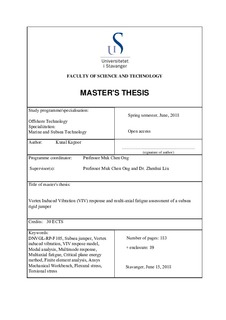| dc.contributor.advisor | Ong, Muk Chen | |
| dc.contributor.author | Kapoor, Kunal | |
| dc.date.accessioned | 2018-08-27T08:28:20Z | |
| dc.date.available | 2018-08-27T08:28:20Z | |
| dc.date.issued | 2018-06-15 | |
| dc.identifier.uri | http://hdl.handle.net/11250/2559384 | |
| dc.description | Master's thesis in Offshore Technology: Marine and Subsea Technology | nb_NO |
| dc.description.abstract | Vortex induced vibrations (VIV) prediction is of interest for subsea jumpers or spools that are exposed to significant current/wave conditions near the seabed. The VIV induces cyclic flexural and torsional stresses in jumper/spool which leads to fatigue damage. Due to jumper/spool’s topology characteristics, multi-axial stress states may exist. The recommended practices for such fatigue damage assessment by DNVGL-RP-F105 (2017 edition) [11] uses the first principal stress method together with the S-N curves. However, the S-N curves are normally based on uniaxial test data and do not represent the real stress state of the system.
In this study, an effort has been made to determine the VIV response using the latest edition of DNVGL-RP-F105 (2017 edition) [11]. The fatigue assessment is carried out by using Farahani [13,14]’s fatigue damage parameter for the first time. This parameter is based on critical plane energy method. The fatigue damage is calculated on a critical plane, which is determined using the maximum shear strain criterion. The phase change due to difference in response frequency of the loads is included in the calculation, which is normally ignored in design practise for VIV fatigue assessments of subsea pipelines.
Furthermore, an effort has been made to highlight the major changes in DNVGL-RP-F105 (2017 edition) [11] edition in comparison to the previous edition of 2006 for the VIV assessment to subsea jumpers/spools. The changes regarding response model and stress range calculation have been discussed as well. | nb_NO |
| dc.language.iso | eng | nb_NO |
| dc.publisher | University of Stavanger, Norway | nb_NO |
| dc.relation.ispartofseries | Masteroppgave/UIS-TN-IMBM/2018; | |
| dc.subject | offshore teknologi | nb_NO |
| dc.subject | subsea jumper | nb_NO |
| dc.subject | vortex induced vibration | nb_NO |
| dc.subject | VIV response model | nb_NO |
| dc.subject | modal analysis | nb_NO |
| dc.subject | multiaxial fatigue | nb_NO |
| dc.subject | critical plane energy method | nb_NO |
| dc.subject | finite element analysis | nb_NO |
| dc.subject | flexural stress | nb_NO |
| dc.subject | torsional stress | nb_NO |
| dc.subject | undervannsteknologi | nb_NO |
| dc.subject | subsea technology | nb_NO |
| dc.title | Vortex Induced Vibration (VIV) response and multi-axial fatigue assessment of a subsea rigid jumper | nb_NO |
| dc.type | Master thesis | nb_NO |
| dc.description.version | submittedVersion | nb_NO |
| dc.subject.nsi | VDP::Technology: 500::Marine technology: 580::Offshore technology: 581 | nb_NO |
